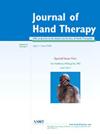A randomized controlled trial on the effectiveness of mirror therapy in improving strength, range of movement and muscle activity, in people with carpal tunnel syndrome
IF 2.1
4区 医学
Q2 ORTHOPEDICS
引用次数: 0
Abstract
Background
There is little information on the potential effects of mirror therapy (MT) on motor recovery in individuals with Carpal Tunnel Syndrome (CTS).
Purpose
To compare the effectiveness of a MT protocol versus a therapeutic exercise (TE) protocol, in improving strength, range of motion (ROM), muscle activity, pain, and functionality in patients with CTS.
Study design
Randomized clinical trial.
Methods
Thirty-nine participants with unilateral CTS were divided into two groups: (i) MT group (n = 20) that followed an exercise protocol applied to the unaffected hand reflected in a mirror, and (ii) TE group (n = 19) that followed the same exercise protocol using the unaffected hand but without a mirror. Strength, wrist ROM, muscle activity, pain and functionality, were assessed at baseline (T0), after treatment (T1) and one month after treatment (T2).
Results
At T1, the MT group showed significantly higher wrist flexion-extension ROM compared to TE (p = 0.04, d = 0.8), maintained at T2 (p = 0.02, d = 0.8). No significant changes were observed in ulnar-radius deviation, pronosupination, or fatigue following either MT or TE (p > 0.05). MT exhibited enhanced handgrip strength at T1 (p = 0.001, d = 0.7), as well as an increase in the extensor carpi radialis (ECR) and flexor carpi radialis (FCR) maximum muscle activity (p = 0.04, d = 1.0; p = 0.03, d = 0.4). At T1, both groups decreased pain (p = 0.002, d = 1.1; p = 0.02, d = 0.7), and improved functionality (p < 0.001, d = 0.8; p = 0.01, d = 0.5) (MT and TE respectively).
Discussion
MT led to enhancements in wrist flexion-extension movement, handgrip strength and functionality unlike TE. MT notably increased muscle activity, particularly in the ECR and FCR muscles.
Conclusions
MT is a favorable strategy to improve wrist flexion-extension ROM, handgrip strength, ECR and FCR muscle activity, and functionality in people with unilateral CTS.
一项随机对照试验,研究镜像疗法在改善腕管综合征患者的力量、活动范围和肌肉活动方面的效果。
背景:有关镜像疗法(MT)对腕管综合征(CTS)患者运动恢复的潜在影响的信息很少:目的:比较镜像疗法(MT)方案与治疗性运动(TE)方案在改善腕管综合征(CTS)患者的力量、运动范围(ROM)、肌肉活动、疼痛和功能方面的效果:研究设计:随机临床试验:39 名单侧 CTS 患者被分为两组:(i) MT 组(n = 20),使用镜子反射的未受影响的手进行锻炼;(ii) TE 组(n = 19),使用未受影响的手进行相同的锻炼,但不使用镜子。分别在基线(T0)、治疗后(T1)和治疗后一个月(T2)对力量、腕关节活动度、肌肉活动、疼痛和功能进行评估:在 T1 阶段,MT 组的腕关节屈伸 ROM 明显高于 TE 组(p = 0.04,d = 0.8),并在 T2 阶段保持不变(p = 0.02,d = 0.8)。无论是 MT 还是 TE,在尺桡偏离、前屈或疲劳方面均未观察到明显变化(p > 0.05)。MT 组在 T1 期的手握力增强(p = 0.001,d = 0.7),桡侧伸(ECR)和桡侧屈(FCR)最大肌肉活动增加(p = 0.04,d = 1.0;p = 0.03,d = 0.4)。在 T1 期,两组患者的疼痛均有所减轻(p = 0.002,d = 1.1;p = 0.02,d = 0.7),功能也有所改善(p 讨论):与 TE 不同,MT 增强了腕关节屈伸运动、握力和功能。MT明显增加了肌肉活动,尤其是ECR和FCR肌肉:MT是改善单侧CTS患者腕关节屈伸活动度、手握力、ECR和FCR肌肉活性和功能的有利策略。
本文章由计算机程序翻译,如有差异,请以英文原文为准。
求助全文
约1分钟内获得全文
求助全文
来源期刊

Journal of Hand Therapy
医学-外科
CiteScore
3.50
自引率
10.00%
发文量
65
审稿时长
19.2 weeks
期刊介绍:
The Journal of Hand Therapy is designed for hand therapists, occupational and physical therapists, and other hand specialists involved in the rehabilitation of disabling hand problems. The Journal functions as a source of education and information by publishing scientific and clinical articles. Regular features include original reports, clinical reviews, case studies, editorials, and book reviews.
 求助内容:
求助内容: 应助结果提醒方式:
应助结果提醒方式:


